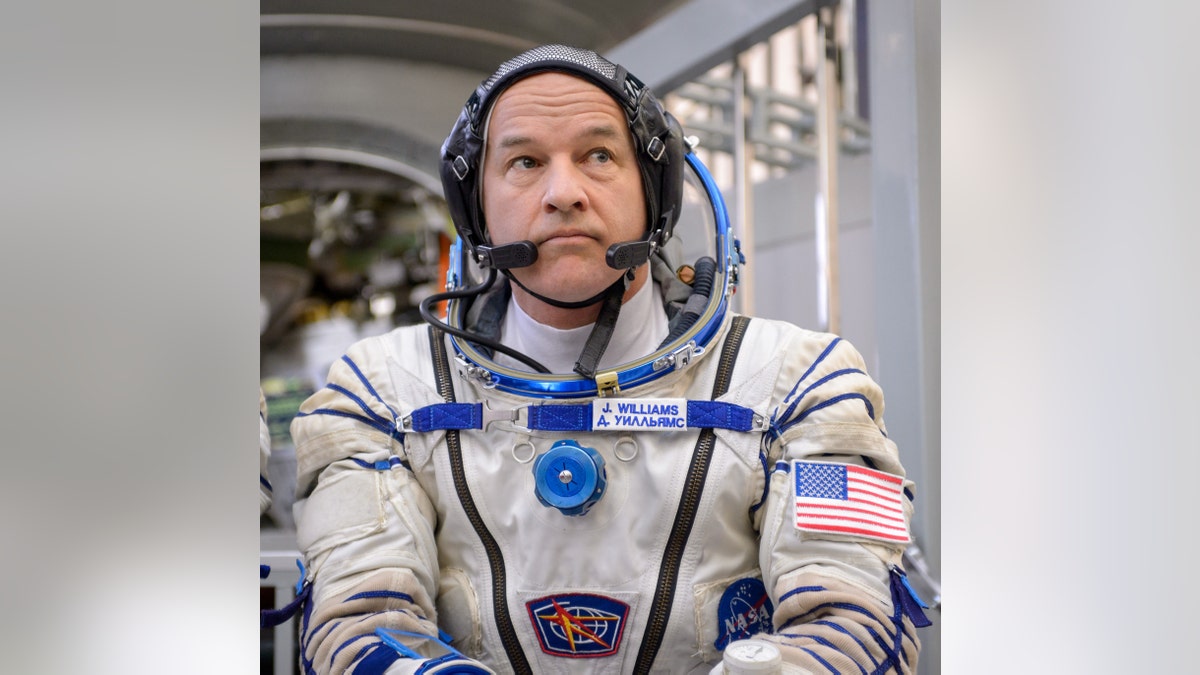
File photo - NASA Astronaut Jeff Williams listens to questions from the media Wednesday, March 4, 2015, at the Gagarin Cosmonaut Training Center (GCTC) in Star City, Russia. Photo Credit: (NASA/Bill Ingalls)
Amid ongoing tension between Russia and the United States, it seems the only place the two countries do get along is up in space.
Both play an integral role on the International Space Station, a fact that will be highlighted March 18 when American astronaut Jeff Williams, along with Russian cosmonauts Alexey Ovchinin and Oleg Skripochka, launch to the space station aboard a Soyuz TMA-20M spacecraft. The launch take place from the Baikonur Commodore in Kazakhstan and the trio join Expedition 47 Commander Tim Copra of NASA, astronaut Timothy Peace of the ESA (European Space Agency), and cosmonaut Yuri Malenchenko of Roscosmos (Russian Federal Space Agency).
Williams, who is making his third-long duration stay on the station, told FoxNews.com that politics on Earth have yet to gravitate to the station. “The international public rhetoric we hear on the news has been above and beyond us and hasn’t really touched us directly,” he said. “It’s almost like we are isolated from it, which I’m very grateful for,” he said.
Related: NASA will tackle asteroids with new Planetary Defense Office
Speaking to reporters at a press conference at the agency’s Johnson Space Center in Houston, Williams also said the cooperation and goodwill on the station allowed the two nations to do much more in space than either could alone – noting how “support kind of diminished rapidly” after the success of Apollo 11.
“The geopolitical circumstances were driving that. The largely symbolic victory was won so the technical objectives weren’t there,” the father of two from Wisconsin said.
“Based on my experience working on the space station, I believe if we weren’t partners with Russia in the international space station neither of our countries would be flying people into space today,” added Williams, who will be spending six months up on the space station. “That is my personal belief. If you examine the history, it’s very logical to come to that conclusion.”
Related: Worldwide telescope network will take best-ever images of Black Holes
Going further, Williams said any future space mission – whether that be to the Moon or to Mars – would have to be done with similar international cooperation. “I can’t image doing that to completion outside of an international partnership,” he explained.
The astronaut is confident that the partnership will remain strong, despite a series of mishaps in recent months involving the Russian space program. In December, one of two defense satellites failed to separate from the Soyuz carrier rocket's upper stage and is believed lost. Before that, a Proton rocket launched in May developed a problem in its third-stage engine eight minutes into the flight, resulting in the loss of a Mexican communications satellite.
That came just a month after the abnormal separation of a Soyuz rocket and unmanned Progress cargo ship after launch on April 28. The cargo ship was stranded in low orbit and soon fell to Earth over the Pacific, delaying the arrival of the scheduled supplies for a six-person crew at the International Space Station.
Related: Supermoon lunar eclipse in pictures
“I have no concerns. The business we are in is a hard business. It’s an unforgiving business. Everyone has experienced problems from time to time,” Williams told FoxNews.com, noting that SpaceX and Orbital Sciences rocket had been lost in the past 15 months. The unmanned missions were carrying supplies to the space station.
The astronaut acknowledged the dangerous nature of spaceflight. “Historically, we know on both sides we’ve had major accidents with losses of life,” he said. “Like I said, this is a hard business we are in and none of us take it for granted. The bottom line is that I am confident in their system (just) as I am confident in our system and the integrated effort that goes on to push forward with the space station program.”
During this mission, crew members will conduct about 250 research investigations and technology demonstrations – some which will enable future long-duration human and robotic exploration into deep space and on the agency’s journey to Mars.
Related: Stunning Perseid meteor shower pictures
The crew members are expected to be at the station for the arrivals of American SpaceX Dragon and Orbital ATK Cygnus cargo spacecraft. Williams is also expected to enter the deployed Bigelow Expandable Activity Module (BEAM), a demonstration of expandable habitat technology that will be attached to the station for two years.
Once the module is deployed, it will offer an additional 565 cubic feet of volume — about the size of a large family camping tent — accessible by astronauts aboard the orbiting laboratory, NASA said. Expandable habitats like this could be a new way to increase the amount of volume available to astronauts, while also enhancing protection against radiation and space junk.
“We’re fortunate to have the space station to demonstrate potential habitation capabilities like BEAM,” said Jason Crusan, director of Advanced Exploration Systems at NASA Headquarters in Washington. “Station provides us with a long-duration microgravity platform with constant crew access to evaluate
